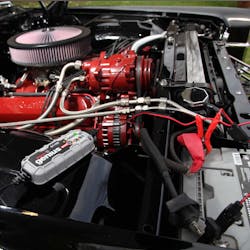“If it ain’t broke, don’t replace it.”
This is often the motto of shop owners with obsolete equipment.
Your customer will come running to you when his equipment breaks. But to get him to replace outdated equipment that’s still working, you need to be more proactive.
Take “Sparky”, that old workhorse battery charger in the corner of your customer’s shop. The old charger is easy to use, reliable -- and paid for. It’s easier for the shop owner to just keep using it than to take the time and money to buy a new smart charger.
But you don’t earn a paycheck by letting your customers stay behind the times.
Q: What’s wrong with “Sparky”?
A: Other than being outdated, nothing. Does the shop still have a rotary phone, too?
An old analog charger is basically a plug, a transformer and two battery cables housed in a clunky case with some switches and maybe a couple of needle dials. Most have wheeled carts so you don’t throw out your back lugging it across the shop.
The old charger works by pushing a steady stream of amps to the battery. That’s all. I’m sure Sparky was once state-of-the art -- but so was black-and-white television. (No offense.)
“A traditional charger is a sledgehammer,” says Jim O’Hara, director of marketing at Clore Automotive. “As the battery becomes fully charged, the battery’s internal resistance increases, which pushes down the charge rate until the charge is almost a trickle. Then you come along and take the charger off the battery.”
You can’t charge new battery technology like AGM (bsorbed glass mat), spiral wound or gel cells with this type of traditional charger, O’Hara says.
Q: What’s the difference? Aren’t all car batteries lead acid?
A: Yes. Today’s gas and diesel-powered consumer vehicles all use 12V lead acid batteries. The most common ones on the road and in your customer’s bay are standard flooded batteries.
“But there are over 65 million non-flooded batteries on the road today,” says Gary Mackey, vice president of sales and marketing for Associated Equipment.
Most of those are AGM, AGM+ or spiral, which is basically electrolyte-soaked woven fiberglass mat between lead plates. New-to-market are EFB (enhanced flooded batteries) with polyester “scrim” to keep the electrolyte closer to the plates. Both of these battery types are commonly used to meet the demands of start-stop hybrid vehicles.
These different battery constructions have different optimum charging characteristics. That’s where a smart charger’s advanced technology makes the difference.
Q: So, what’s so smart about a smart charger?
A: Where a traditional charger is a lightning bolt on wheels, a smart charger is a battery charger with a brain.
Instead of a brute force transformer, a smart charger uses algorithms and pulse width modulation to charge a battery according to the construction and state of discharge of the battery. Just select the battery type on the control panel and the smart charger does the rest.
New battery technology demands specific charging steps be followed, says O’Hara. “You’re going to have a volt charging phase, an absorption charging phase, and you may have additional phases beyond that as well … but those are fundamentally what’s required.”
Q: What happens if you don’t use a smart charger to charge a new technology battery?
A: Depends who you ask. One expert I spoke to said you’d ruin the battery. The rest said a one-time charge with an old-fashioned charger would not cause significant harm. But everyone agreed multiple uses of an old charger could significantly shorten battery life on new battery technology.
So, it seems fleets have a vested interest in smart chargers to extend battery life. Keep this in mind next time you call on a fleet maintenance customer.
Q: What new features can I focus on to convince my customer it’s time to retire Sparky?
A: It depends on your customer. Some will be swayed by safety, others by productivity and others just like to embrace the newest technology.
Like most shop equipment, there’s no universal list of features everyone has. Each manufacturer has different feature sets and cleverly-branded feature names. But there are several core functions that you’ll find across all modern chargers.
Here’s some basic features you can present to your customer to convince him to add a new smart charger (or several) to his shop (no need to trash Sparky, he still serves a purpose):
Safety - Ever seen a battery explode? Then you know how dangerous the shrapnel and acid spray can be. (If not, check out the first 30 seconds of this video: youtu.be/d_TnsHu2u4c)
Most smart chargers have several features that make for a safer shop. These safety features don’t guarantee a battery won’t explode. But it will minimize the risk:
- Automatic “off” switch - A sensor shuts off the unit when fully charged. This also protects the battery from overcharging, which can cause damage especially in newer technologies. I’m not encouraging you to charge a battery unattended overnight, but this makes it safer to do so.
- Polarity protection - If you accidentally connect a positive cable to a negative post or vice versa, the charger won’t turn on. This protects the charger, the battery and, most importantly, the technician.
Battery recovery - Walk through any parking lot randomly testing batteries and you’d probably find every one in a state of discharge, says Jonathan Lewis Nook, president and chief visionary officer at The NOCO Company. A battery in constant discharge ends up with battery sulfation (or “crud on the lead plates,” in my most eloquent description). Sulfation can cause premature failure and prevent a battery from adequately recharging.
That’s where Deep Discharge Recovery comes in (branded as rejuvenation mode, the repair function and other catchy names.) Using a series of rapid amperage pulses over several minutes before beginning the full charge cycle the charger descales a sulfated battery, says Nook. Not every battery is recoverable, but this process can resurrect the ones that are.
Portability and storability - The advantage of the small size and lighter weight of smart chargers makes them easier to carry around the shop, says Nook. And with many sub-$200 units available, the average diagnostic technician may choose to buy his own smart charger and store it in his toolbox.
Built-in testing - Most smart chargers have some level of built-in testing features.
A good smart charger will at least measure basic battery health. Technicians want to know if a battery will hold a charge before wasting several hours trying to charge a bad battery.
A charger that does testing upfront improves productivity and saves a technician time in the long run, says Lance Losinski, performance manager for charging and networking at Midtronics.
“We have a diagnostic charger, which is the next level,” says Losinski. “The diagnostic charger will diagnose the battery at the beginning, all throughout and at the end.”
Power boost - I think everyone I talked to had a setting to jump-start a car with a dead battery so the technician can move it in or out of a bay. It’s the same thing old Sparky did, but an important feature if the smart charger is the only charger you have in your shop.
Q: Is there a season that’s best to sell battery chargers?
A: Battery sales season is charger sales season.
Temperature extremes affect battery chemistry, says Don Russell, battery charger product manager at Cornwell Tools. So, if you live in a warm-weather state, your customer will be putting his charger to the most use in summer. In cold-weather states, winter tends to be when the charger is getting the most use. Sales parallel usage.
So, you should push chargers in spring/fall as appropriate to your climate -- whether or not your flag or WD puts them on special. Create a flyer or truck display. Since smart chargers are smaller, you may tote and promote it in the shop with a quick demo. But that’s your call.
Q: How many chargers should a shop have?
A: What would you say to a charger in every bay? While that may be only a dream today, one charger for every two bays is a more common recommendation, says Mackey.
Why so many? Key-on testing can quickly drain a battery. Even just a small drop in voltage can make diagnostics difficult. When doing any underhood diagnostic work, it’s a good idea to keep every vehicle on a charger at least in maintenance mode, says O’Hara.
You need to be proactive to sell more equipment. Don’t just take orders. Ask for orders. Asking for charger orders can create happier customers and power more profits for your business.
About the Author

Phil Sasso
Phil Sasso is president of Sasso Marketing Inc. (www.sassomarketing.com), a technical marketing agency providing advertising, public relations and promotional services to tool and equipment marketers. Subscribe to his free marketing tip at philsasso.com/blog.
